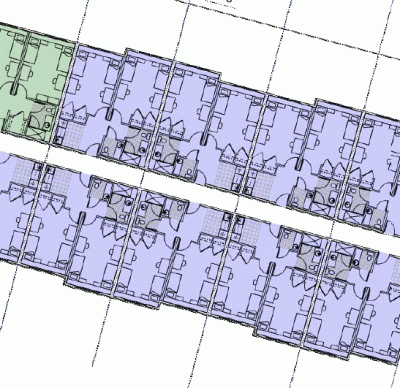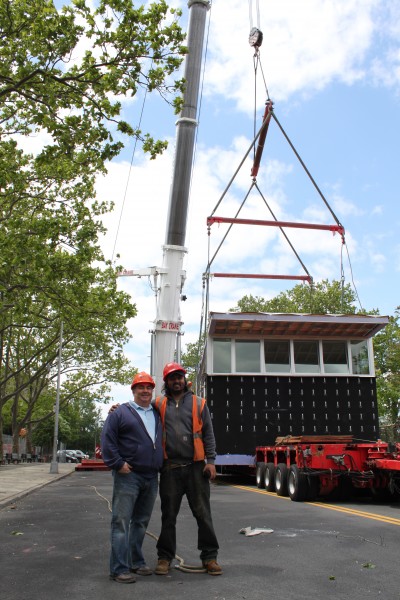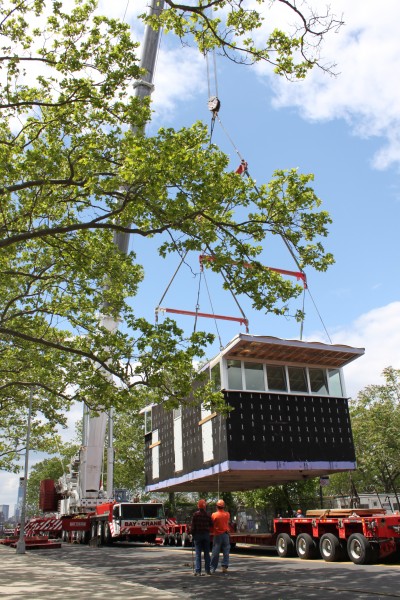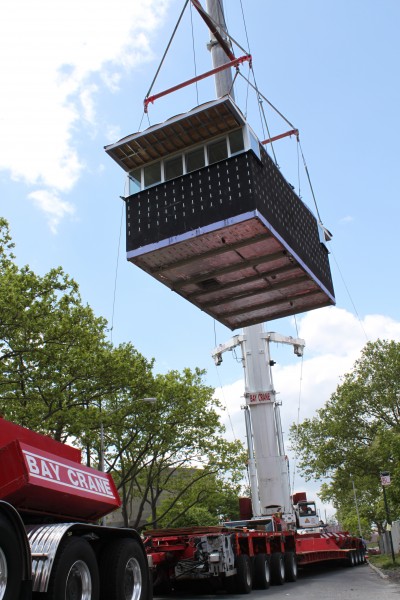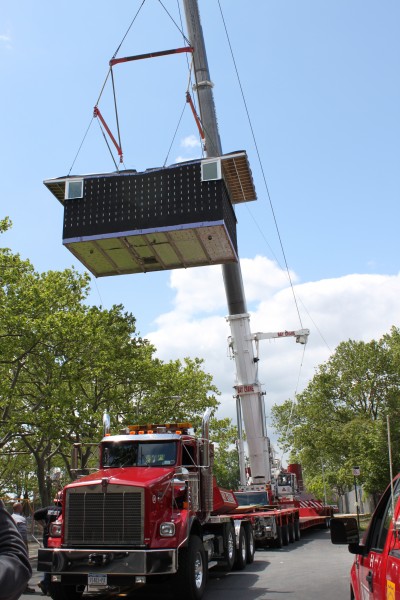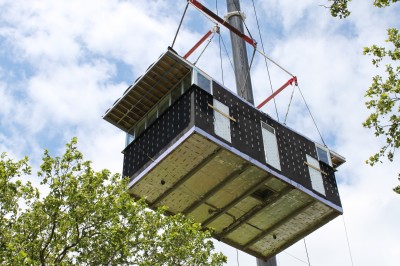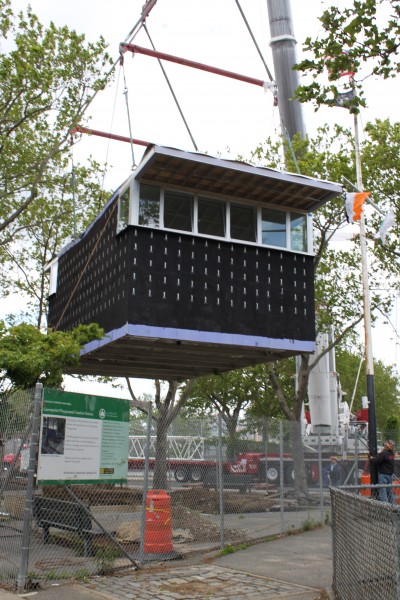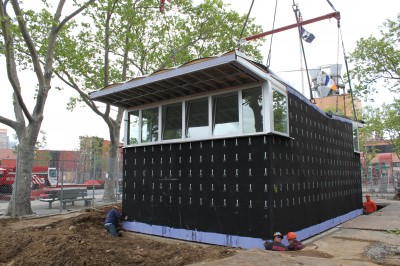Daily News about Nehemiah Spring Creek
Tags: Affordable Housing, High Quality Construction, Lean manufacturing, modular building, Nehemiah Spring Creek - Phase III, Non Combustible Construction, offsite construction, Prefabrication
Spring Creek Nehemiah is an affordable housing success story in East New York
The development off Flatlands Ave. is home is home to 233 first-time homeowners who won the right to live there via lottery.
By Jason Sheftell / NEW YORK DAILY NEWS
Friday, July 27, 2012, 11:43 AM

Aaron Showalter/for New York Daily News
Spring Creek Nehemiah is East New York is one of the city’s great housing success stories. Already, 233 first-time owners have moved into these well-designed townhomes.
Linda Boyce says it happens all the time. People turn off Flatlands Ave. in East New York, Brooklyn, and slowly cruise Linwood, Vandalia, and Egan Sts. They look around, admiring multi-colored boxy houses with big backyards, private driveways, and patches of front gardens.
“Someone always asks ‘How can I live here?’ ” says Boyce, a member of the first Homeowner Association at Nehemiah Spring Creek, one of the city’s largest affordable homeowning developments and a national model for affordable housing programs. “That makes us proud. We work hard to keep this neighborhood clean and safe. Sometimes I forget I’m in Brooklyn.”
In what is the city’s newest neighborhood, Spring Creek Nehemiah (as residents call it) is home to 233 first-time homeowners who won the right to live at Nehemiah in a lottery sponsored by the city’s Department of Housing Preservation and Development, a major partner in the project. They applied to the lottery more than five years ago, some as many as 17 years back. Soon, 50 new owners will move in. Five parks, a supermarket and EMS station will be finished upon plan completion.

Aaron Showalter for New York Daily News
From left, proud Nehemiah owners Milagros Gerez, Walja Moody, Linda Boyce, organizer Grand Lindsay, Roxanne Thomas, Elizabeth Daniel, and Dawn Brown.
Built in partnership with East Brooklyn Congregations and designed by architect Alexander Gorlin, Nehemiah is composed of prefabricated one-, two- and three-family homes assembled at the Brooklyn Navy Yard. Homeowners put down as little as $8,000 to purchase their houses, which ranged in price from $158,000 to $488,000.
PHOTOS: An insider’s guide to New Lots Ave., Brooklyn
When completed by 2016, over 1,525 new homes and apartments will be built on these streets tucked in behind Related Companies Gateway Plaza Mall, Belt Parkway, and two state parks opening by 2014. In September, three new schools will open on a $75 million campus constructed by the Department of Education.
Boyce and her fellow homeowners are part of phase one. They work hard daily to ensure their streets, homes and neighborhood stay safe and clean.

Aaron Showalter for New York Daily News
Linda Boyce shows off her kitchen in a Spring Creek Nehemiah home.
As you enter the area dominated by the Nehemiah prefab houses, it has the feel of newness. It’s cleaner than a hospital. On a quiet and hot Saturday, it feels like a movie set. But life lives inside these homes. Some people have pools, others gardens and outdoor patios with Southern smokers. People on the streets say hello to one another. They stop to talk about meetings, fairs, the new school and construction phases
Grant Lindsay, an organizer for East Brooklyn Congregations (EBC), knows a tight-knit neighborhood has more power combating local problems.
“Our job just doesn’t stop when people move in,” says Lindsay, who has helped EBC members empower themsleves in Brownsville, East New York and Bushwick. “That’s when it starts. We help work together to achieve their needs. Often big government and landlords take advantage of people. We don’t want that to happen. At Nehemiah, we want to build a strong community. This is a place that looks out after each other and is proactive in seeking change. A home is just a home. A neighborhood takes relationships.”

Aaron Showalter for New York Daily News
A row of three-family houses on the edge of the development. Construction on phase-two homes has already began. Fifty new homeowners will move in shortly.
Block by block, Lindsay works with homeowners to set up monthly meetings. Already they have rallied to make crossing Flatlands Ave. safer for seniors and worked to establish a relationship with the Academy for Young Writers, the high school moving from Williamsburg to East New York this fall.
“We make things happen ourselves,” says Roxanne Thomas, owner of a three-family house. “I live across from an empty lot where they are going to build. People used to ride dirt bikes there. It was noisy. I worked with police to ask them to leave. The block is quiet again.”

Dawn Brown lives across the street from a football field that serves as a practice and game-day facility for Thomas Jefferson High School. The single mom jokes about her master bedroom being the “mistress bedroom.” Taking pride inside and outside the home, Brown cuts the grass along the practice field fence herself.
“It just looks better,” she says. “We want this to be an inspiration for the entire area. You won’t see spray paint here. You don’t hear loud music. People respect each other here.”
More than respect, homeownership in Spring Creek Nehemiah reaches spiritual heights.
Homeowner Elizabeth Daniel got burned in a Canarsie foreclosure scandal, losing a down payment. Her grandmother instilled in her the goal of homeownership. She started saving again, and received word in 2010 that she had won the right to own a home in Nehemiah. Daniel lives in a two-family with her husband. She loves the bay window and placement on her home on Vandalia St.
“Every day I stop for a moment to thank God for being here,” says Daniel, who works in higher education. “I’m going to make the most of it. We’re going to make sure this place is the best it can be.” Walja Moody came to New York from Alabama. She forgot she applied for a Nehemiah home until 14 years later when the application arrived.
“I had just been divorced,” she says. “I was head of the household and thinking, ‘How am I going to do this?’ ” she says. “It’s very fulfilling to be part of a community that is growing and evolving. We are all in this together here. We are not rich people. These homes and this neighborhood are our lives.”
A philosophical architect with a conscious, Alexander Gorlin was aware of the importance architecture would have in the community. He and his firm have been working on the project for 12 years. Gorlin’s take on the updated brownstone for middle-class New Yorkers was honored in an exhibition on prefab houses at the Museum of Modern Art. It feels “heartening,” he says, to walk Nehemiah today.
“You feel the power of architecture at work creating a beautiful place for people to live,” says Gorlin. “There is such attention to detail, like that in a wealthy person’s home, that in ways it confirms that the people who live here are important. All the homes are not alike. They allow for individuality in a communal setting. I think that helps it work.”
Boyce, who has a corner one-family across from the new school, redesigned her kitchen with granite countertops and custom-made cabinetry. She redid her floors a darker wood.
“I had a niece come to visit, and from the outside she said it looked so small,” says Boyce. “When she came in, she couldn’t believe how big it is. When the school opens, it will be wonderful to hear children laughing and playing. We’re working to see how we can help them.”
Set to open in September, the educational structure will house three schools: the Academy for Young Writers, where 60% to 80% of the students live in East New York and Brownsville; the Spring Creek Community School, which starts at sixth grade, and P53K for special-needs students. The high school’s principal, Courtney Winkfield, sees a link between the neighborhood and the school.
“We chose to be in this neighborhood,” says Winkfield, whose school was formerly housed in a Williamsburg walkup with electrical wiring so old multiple computers couldn’t power up. “Not only is it where our students live, it’s a place with strong spirit. We’re discussing mentorship programs to stay connected to our neighbors. The people at Nehemiah are pioneering a new area.”
For EBC, the drive for quality housing and empowered community is constant.
“The homes we build are named after the Old Testament figure Nehemiah, who helped rebuild Jerusalem after it had been destroyed,” says Lindsay. “With each home, we try to embody that same spirit of hope in the face of despair. It’s ironic. This is one of the signature achievements of the Bloomberg third term, but the mayor hasn’t been here. We hope he comes to see this.”
YOU SHOULD KNOW
What: Nehemiah Spring Creek, an affordable housing success story in East New York. Phase three homes start at $190,000 with about $10K down.
Where: Near Gateway Plaza Mall off Flatlands Ave. Take the 3 train to New Lots Ave. and the B6 to Nehemiah Spring Creek near Linwood St.
How: Go to nyc.gov/hpd for lottery info. For more on East Brooklyn Congregations, go to ebc-iaf.org.
See also:
http://www.capsyscorp.com/nextlevelbuilding/?p=814

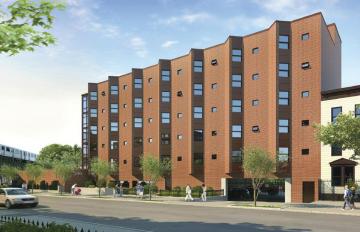
 Few, if any, companies can say they built a luxury hotel in less than one year, but that’s exactly what
Few, if any, companies can say they built a luxury hotel in less than one year, but that’s exactly what 

